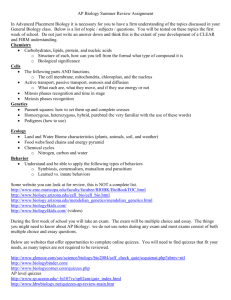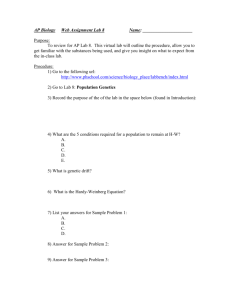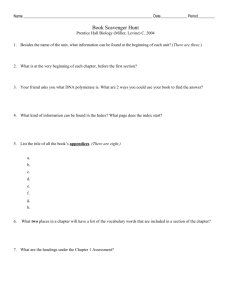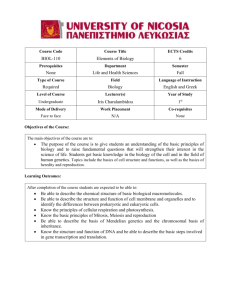Biology Course Syllabus
advertisement
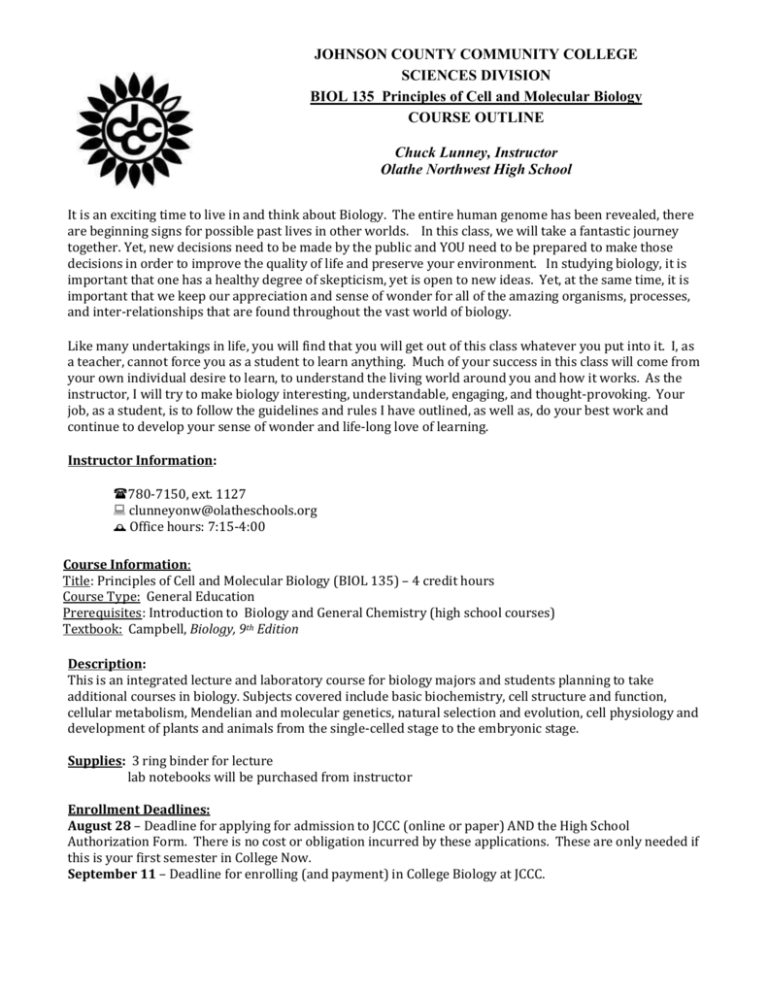
JOHNSON COUNTY COMMUNITY COLLEGE SCIENCES DIVISION BIOL 135 Principles of Cell and Molecular Biology COURSE OUTLINE Chuck Lunney, Instructor Olathe Northwest High School It is an exciting time to live in and think about Biology. The entire human genome has been revealed, there are beginning signs for possible past lives in other worlds. In this class, we will take a fantastic journey together. Yet, new decisions need to be made by the public and YOU need to be prepared to make those decisions in order to improve the quality of life and preserve your environment. In studying biology, it is important that one has a healthy degree of skepticism, yet is open to new ideas. Yet, at the same time, it is important that we keep our appreciation and sense of wonder for all of the amazing organisms, processes, and inter-relationships that are found throughout the vast world of biology. Like many undertakings in life, you will find that you will get out of this class whatever you put into it. I, as a teacher, cannot force you as a student to learn anything. Much of your success in this class will come from your own individual desire to learn, to understand the living world around you and how it works. As the instructor, I will try to make biology interesting, understandable, engaging, and thought-provoking. Your job, as a student, is to follow the guidelines and rules I have outlined, as well as, do your best work and continue to develop your sense of wonder and life-long love of learning. Instructor Information: 780-7150, ext. 1127 clunneyonw@olatheschools.org Office hours: 7:15-4:00 Course Information: Title: Principles of Cell and Molecular Biology (BIOL 135) – 4 credit hours Course Type: General Education Prerequisites: Introduction to Biology and General Chemistry (high school courses) Textbook: Campbell, Biology, 9th Edition Description: This is an integrated lecture and laboratory course for biology majors and students planning to take additional courses in biology. Subjects covered include basic biochemistry, cell structure and function, cellular metabolism, Mendelian and molecular genetics, natural selection and evolution, cell physiology and development of plants and animals from the single-celled stage to the embryonic stage. Supplies: 3 ring binder for lecture lab notebooks will be purchased from instructor Enrollment Deadlines: August 28 – Deadline for applying for admission to JCCC (online or paper) AND the High School Authorization Form. There is no cost or obligation incurred by these applications. These are only needed if this is your first semester in College Now. September 11 – Deadline for enrolling (and payment) in College Biology at JCCC. Important Notice: You must understand that enrollment in College Now constitutes a commitment to do college level work. If you must withdraw from this course, it is your responsibility to do so at JCCC in addition to withdrawing from Northwest. If you do not withdraw from JCCC, you will receive a failing grade on your permanent college transcript and damage you college grade point average. . Course Objectives: Upon successful completion of this course the student should be able to: 1. 2. 3. 4. 5. Describe basic biochemical molecules. Identify cellular structures and know their functions. Describe the basic principles of cellular metabolism. Identify and explain the forms and processes of cell division. Identify the basic principles of Mendelian and molecular genetics, and relate these theories to Natural selection and evolution. 6. Explain the basic principles of cellular physiology. 7. Apply the Scientific Method in a laboratory setting. 8. Correctly use scientific equipment. Content Outline & Competencies: Expect Weekly Quizzes – you’ll need to complete work on the book website AND keep on top of studying. You’ll need to read your textbook and review your notes. I. Basic Biochemical Molecules A. Distinguish between atoms and elements and list the six elements that compose over 90% of living matter. B. Name the subatomic particles and relate the atom’s structure to its chemical properties. C. Describe electron orbital configuration and how it affects an element’s reactivity. D. Name the three types of chemical bonds and how each is formed. E. Describe the mechanism of enzymes as catalysts in chemical reactions. F. Identify the four major groups of organic molecules and describe their functions. II. The Cellular Structures and Their Functions A. Describe the cell theory. B. Differentiate between prokaryotic cells, eukaryotic cells and viruses. C. Describe the advantages of specialization in eukaryotic cells. D. Describe structure and function of a cell wall, plasma membrane, and cytoskeleton. E. Name and explain the functions of organelles comprising eukaryotic cells. F. Describe the fluid mosaic model. III. The Basic Principles of Cellular Metabolism A. Define energy and the laws of thermodynamics B. Explain the role of ATP as an energy coupler. C. Outline the generalized formula for photosynthesis. D. Describe the light-dependent and light-independent pathways of photosynthesis. E. Relate the structure and function of a chloroplast. F. Outline the generalized formula for aerobic respiration. G. Describe glycolysis, Kreb’s cycle and the electron transport chain. H. Relate the structure and function of a mitochondrion. I. Compare aerobic and anaerobic respiration. IV. The Forms of Cell Division A. Describe binary fission. B. List the stages of the cell cycle. C. Describe the phase of mitosis and meiosis. D. Compare the results of mitosis and meiosis. E. Differentiate between nuclear division and cytokinesis. F. Distinguish between asexual and sexual reproduction. G. Describe reproduction and development in plants and animals. V. The Basic Principles of Mendelian and Molecular Genetics A. Explain the Mendelian principles of heredity B. Relate the steps of meiosis to the Mendelian principles of heredity. C. Describe inheritance patterns including dominance, incomplete dominance, codominance, epistasis and pleitropy. D. Outline the steps in DNA replication. E. Describe transcription and translation. F. Describe the mechanisms that cause mutations. G. Explain how genes are regulated in eukaryotes and prokaryotes. H. Explain the mechanisms of natural selection, and how new species are formed. I. Identify the methods utilized in genetic engineering. VI. The Basic Principles of Cellular Physiology A. List three types of neurons and their impulse pathways. B. Explain how a neural impulse is generated and conducted. C. Identify glands of the human endocrine system. D. List examples of hormones produced by glands. E. Explain how hormones travel through a human body, and how they are recognized by target cells. F. Explain the sliding filament theory of muscular contraction. G. Describe the structure, and explain the functions of antibodies. H. Describe how B- and T-lymphocytes function in the specific immune response. I. Describe the cohesion-tension theory and pressure-flow hypothesis for plants. VII. Apply the Scientific Method in a Laboratory Setting A. Construct testable hypotheses B. Perform experiments C. Analyze experimental results VIII. Demonstration of the Proper Use of Scientific Equipment A. Use microscopes B. Make wet mounts for use in microscopes studies C. Make measurements using the metric system D. Use computer software simulation program. TIMELINE WEEK/UNIT TOPIC LABS/ACTIVITIES MAJOR ITEMS DUE Week 1 Introductory Unit JCCC Credit Syllabus Safety Online logins Pre-Test Google Classroom and Mastering Biology login Unit 1 Weeks 2 and 3 Chapter 1 and Lumbriculus Lab Scientific Method General Themes of Biology Inquiry in Science Chemistry for Biology Properties of Water Lumbriculus Lab Lab write-up Unit 1 Exam Acid Precipitation Virtual Lab Unit 2 Exam Carbon and It’s Properties Functional Groups Carbohydrates, Lipids, Proteins, Nucleic Acids Molecular Modeling Identification of Macromolecules Lab Lab Write up Unit 3 Exam Unit 2 Weeks 4 and 5 Chapter 2 and 3 Unit 3 Weeks 5,6 and 7 Chapters 4 and 5 ACT Preparation Week 8 ACT Strategies, Tips and Practice Pre- and PostTests Unit 4 Weeks 9, 10 and 11 Chapters 6 and 7 Types of Cells Lab Cell Transport Lab Lab Write up Unit 4 Exam STEM Career Exploration Unit Week 11 an 12 The Cell Microscopy Membrane Structure and Function/Transport STEM Careers Online research Field trip/KState Olathe Speakers Interest Summaries All Lab Write Ups Enzyme Lab Photosynthesis Lab Cell. Resp. Lab Modeling Mitosis Mitosis Lab Chi Square Analysis Unit 5 Week 13, 14, 15 Chapters 8, 9 and 10 Unit 6 Week 16, 17 Chapter 12 Week 18 Metabolism/Enzymes Photosynthesis Respiration Cell Cycle Mitosis 1st Semester FINAL EXAM SEMESTER 2 Unit 6 Week 1 Chapter 13 Unit 7 Weeks 2, 3 and 4 Chapters 14 and 15 Cancer Meiosis Mendelian Genetics Molecular Genetics Unit 6 Exam Unit 8 Weeks 5, 6 and 7 Chapters 16 and 17 Unit 9 Weeks 8, 9 and 10 Chapters 20 and 21 DNA structure and function Mutations Protein Synthesis Biotechnology Unit 10 Weeks 11, 12 and 13 Chapters 27, 45 Unit 11 Weeks 14, 15 and 16 Week 17 Cellular Physiology Neurons/Neural Impulse Endocrine System Immune Response Conservation Biology Genetics Lab using Wisc. Fast Plans Blood Typing Simulation Virtual Drosophila Lab Lab Write ups DNA Extraction Lab Lorenzo’s Oil Lab Write up Gel Electrophoresis Lab Henrietta Lacks Lab Write Up Bacteria Lab Thyroxine/TSH Virtual Lab Ecosystem Development Project Unit 7 Exam Unit 8 Exam Stem Cell Socratic Seminar Unit 9 Exam Lab Write Up Unit 10 Exam Group Presentations Final Exam Methods of Evaluation of Competencies/Course Requirements: Evaluation of student mastery of course competencies will be accomplished using the following methods: Each student is required to complete the assigned reading each week as well as work on the Campbell website, take exams worth 100 points each. These exams will be worth 60% of the grade. (This will include your semester final exams) Each student is required to complete additional material, which will include weekly quizzes, papers, homework assignments, etc. as determined by the instructor. This will be worth 15% of the grade. Quizzes will be given on a regular basis as formative assessments. This will be worth 10% of the grade. Students will be required to keep detailed, organized lab notebooks. The grades on these and/or on lab practicals will be combined and will be 15% of the grade. Grading Criteria: A = 90% - 100% B = 80% - 89% C = 70% - 79% D = 60% - 69% F = 0% - 59% Technology Expectations: **Students may use electronic devices only at the discretion of the teacher. **Students will need basic word processing and Internet searching skills for the completion of some papers, exercises, and projects. Plagiarism – as defined in the Code of Student Conduct for Olathe District Schools is a Class I Offense. Class I Offenses (13.) ACADEMIC DISHONESTY: Plagiarism, cheating on tests, copying assignments or papers, placing parent/teacher signature on document. Plagiarism/Cheating This is when an individual uses another person’s ideas, expressions or writing as if they were his/her own. Acts of plagiarism include the following: Presenting another’s essay or class assignment as one’s own Failing to acknowledge the source when repeating another’s wording or particularly apt phrase Failing to acknowledge the source when paraphrasing another’s argument Failing to acknowledge the source when presenting another’s line of thinking Making slight changes in wording from another source so that the passage is not copied word for word Copying from another person’s test STUDY SUGGESTIONS: Focus in class – paying attention in class can save you hours of studying outside of class. This is a college level course and the class will be handled as such; you will be graded primarily on tests, quizzes and labs and you will be expected to monitor and analyze your own learning. Biology is different from other introductory courses in terms of the amount of vocabulary involved to get a basic understanding of the science. You must study some every day. Waiting until just before the exam to read the material and review your notes is a bad idea. Staying on top of the material (reading in advance of class discussions and labs) will help you develop a deeper understanding and keep the material from seeming overwhelming and confusing. There are tutorial activities (online) for each topic – these are highly useful – use them and bring any questions you have to class. Make use of ALL online resources, especially the Campbell Biology Website. Come in for help or get help from a classmate as soon as you have trouble with a concept; you need to be an advocate for your own learning. Consider forming a study group, even if it’s only with one other person. Keep an organized lab notebook and organized notes. Your syllabus is your best friend in this class – check it frequently and use it to plan your studying. After a quiz or test take time to figure out why you missed questions – think about whether you misread the question or needed to study more. If you needed to study more, do it right away – the concepts build on each other AND you will be having comprehensive exams at the end of both semesters. Make sure you do your labs carefully and completely and that you understand what you’re doing and why you’re doing it. Make up labs immediately – biology lab materials usually have a short shelf life – you can’t do a lab if the organisms/materials are no longer fresh, no longer alive, or are no longer in the right stage of their life. As stated earlier, expect WEEKLY quizzes – keep on top of studying. You’ll need to read your book; utilize the Campbell website for activities, quizzes, and vocabulary; review your class notes; do the chapter study guides and any worksheets. Please sign and return this page of the syllabus. By signing, the student and parent(s)/guardian(s) acknowledge the expectations explained in the syllabus and agree to abide by them. STUDENT NAME (PRINT) ________________________________________________ STUDENT SIGNATURE ________________________________ DATE ____________ ……………………………………………………………………………………………… PARENT/GUARDIAN NAME (PRINT) ______________________________________ PARENT/GUARDIAN SIGNATURE ______________________ DATE ____________ **PARENT EMAIL (PRINT CLEARLY)______________________________________
